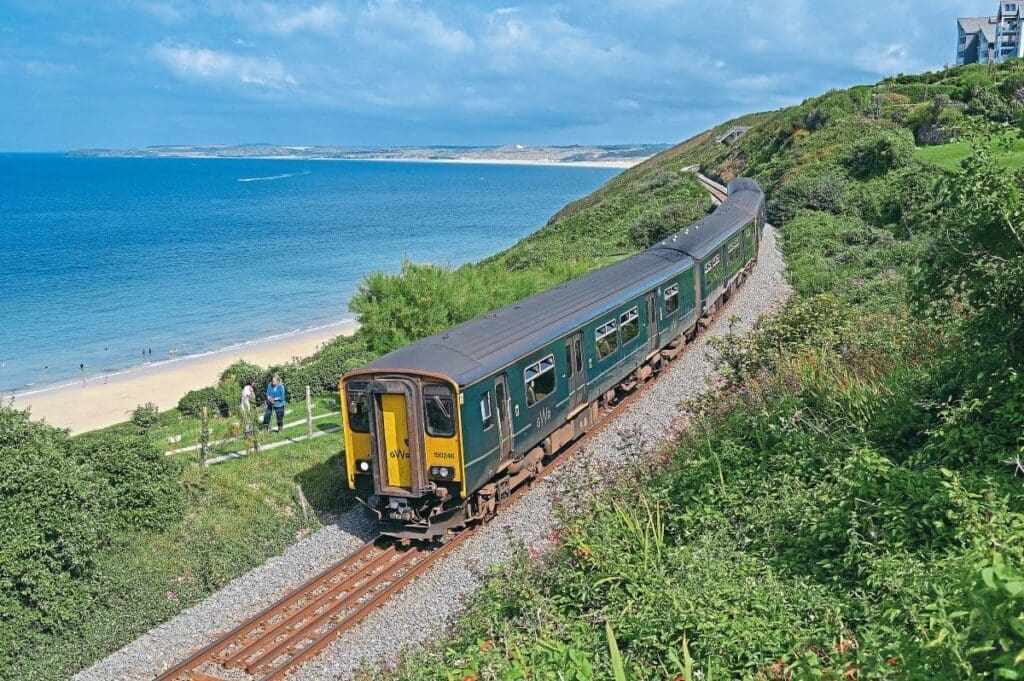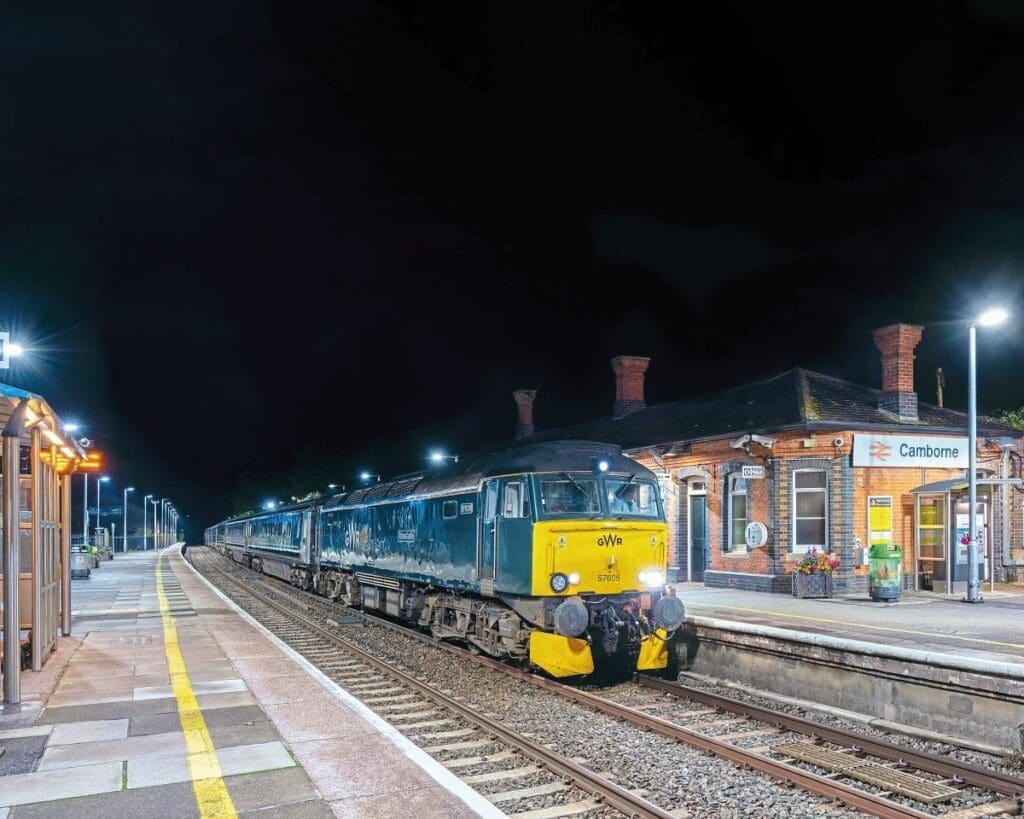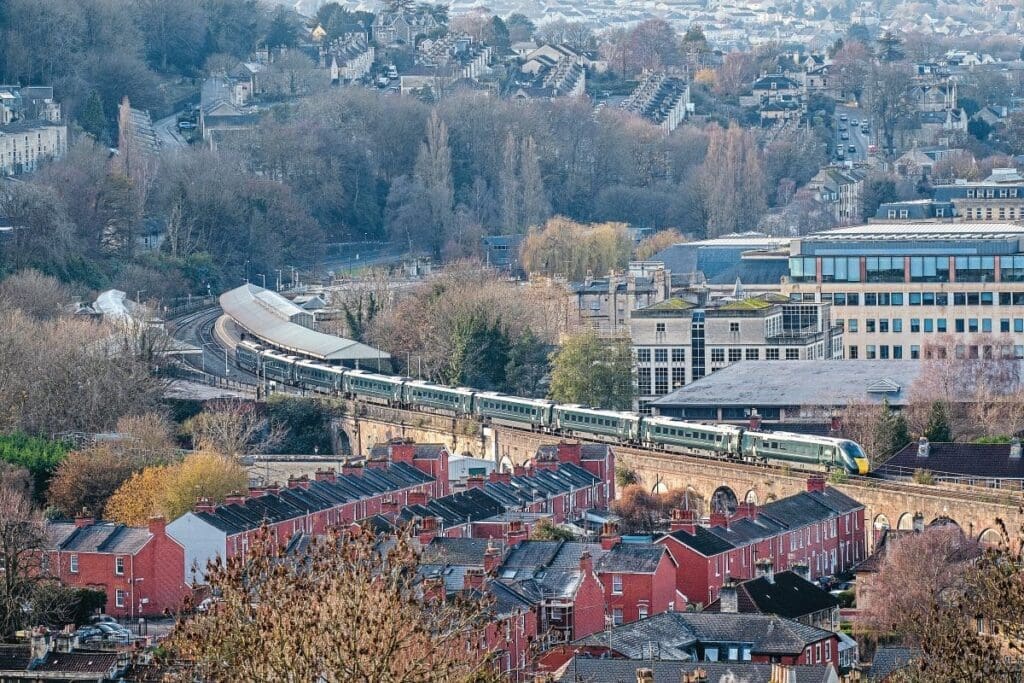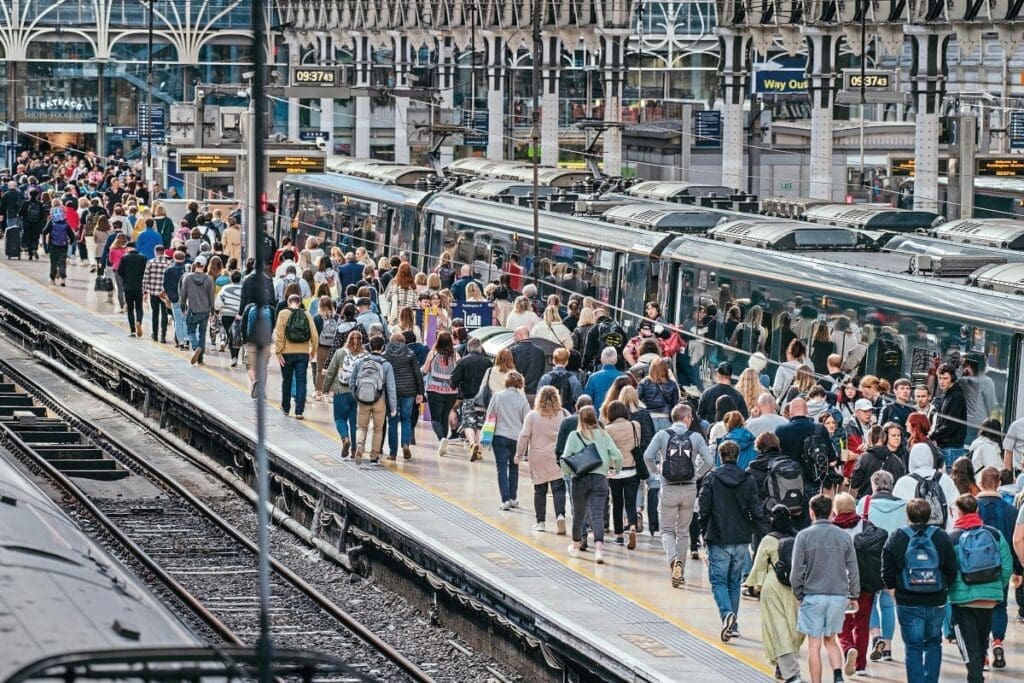Mark Hopwood has been managing director of Great Western Railway for almost 16 years, during which time there has been significant change. As the operator looks to the future, he talks to Richard Clinnick about those plans.

Great Western Railway is once again preparing significant changes on its network.
Since 2014, the Great Western Main Line has been electrified, between London Paddington and Cardiff Central, and from Reading to Newbury. Planned electrification from Didcot Parkway to Oxford, from Chippenham Junction to Bristol Temple Meads via Bath Spa, and from Cardiff Central to Swansea, which were all part of the original wiring plans, were cancelled on cost grounds as the Great Western electrification project expenses soared.
Enjoy more Rail Express Magazine reading every month.
Click here to subscribe & save.
On October 16, 2017, the first Hitachi Intercity Express Trains (IETs) entered traffic, and the subsequent introduction of 93 IETs enabled GWR to remove High Speed Trains from long-distance services from London in May 2019. But that wasn’t the end of the HSTs. Due to the delays to the GWML electrification, the planned cascade of diesel trains west was affected, with GWR deciding to operate a small fleet of short-formed HSTs in the west country to cover for diesel multiple units being forced to continue on routes that should have been electrified.
A fleet of 11 four-coach sets, later increased to 16, was modified, with sliding doors and controlled emission toilets fitted to the Mk.3s allowing them to meet accessibility standards. These entered traffic on the Cardiff-Penzance, Cardiff-Taunton, Worcester-Bristol and Plymouth-Penzance routes.
Delays in electrification saw 21 Class 801/3 electric multiple units originally ordered for GWR instead delivered as bi-mode ‘800/3s’, thus improving their flexibility. The IET fleet includes 36 Class 802s ordered separately from the Intercity Express Programme Class 800s.
Another fleet ordered was the Class 769/9 tri-modes. Based on Porterbrook’s Flex, which took redundant Class 319s and converted them to bi-mode by fitting a diesel engine, the GWR version took the project on a step by keeping both the overhead and third-rail electrification capabilities, but added the diesel power. The 19 four-car sets were destined for the Thames Valley and Gatwick Airport routes and would allow for the cascade of DMUs west. However, due to various delays, these trains never entered traffic and were returned to Porterbrook earlier in 2023 when their lease expired.
Also on the Thames Valley, MTR Elizabeth Line (MTREL) took over the inner suburban services as the Heathrow Connect service. GWR now operates alongside MTREL eastwards from Reading, with its Class 387/1 fleet used on electric services to Didcot Parkway. These changes freed Electrostars to serve Cardiff Central too.

In charge through all the changes has been GWR managing director Mark Hopwood. A well known rail enthusiast, he joined GWR in January 2008. He held a similar role at South Western Railway on an interim basis for 12 months from January 2020 but remained at GWR.
Rail Express met him in GWR offices adjacent to London Paddington on November 21. Typically for someone so hands-on, he’d been dealing with ‘operational issues’ prior to the interview. He speaks with passion and enthusiasm for the railway, about what has been achieved and what is to come. And there is certainly a lot to come.
“We are pleased there’s a lot of positive things happening in what is quite frankly quite a challenging environment.” He points to the opening of new stations on the GWR network. These include Okehampton, where 550,000 passenger journeys have been made since it reopened on November 20, 2021, some 49 years after it reopened (see Headline News), Reading Green Park, which opened on May 27, Marsh Barton (near Exeter), which opened on July 4, and Portway Park & Ride which opened on August 1. “I think it’s good to see the new stations open. There’s a lot of talk about opening new railway lines and stations, but not always as much delivery as people would like. We’re pleased to have achieved that.”
He says there is more coming too. A station at Ashley Down is due to open during 2024, between Filton Abbey Wood and Stapleton Road in Bristol. This will feature two accessible platforms and provide journeys of around 10 minutes to Bristol Temple Meads. There will be an hourly frequency, increasing to half-hourly at peak times. This station is being funded by the West of England Combined Authority with some additional funds from Bristol City Council, South Gloucestershire Council and GWR, and forms part of the wider MetroWest programme of rail enhancements.
Other stations in the planning stage are at Cullompton and Wellington, between Exeter and Tiverton Parkway, Edginswell on the outskirts of Torquay, Charfield (between Yate and Cam & Dursley), the new HS2 station at Old Oak Common (see panel), the Henbury line as part of Phase 2 of Bristol’s MetroWest project which aims to reintroduce passenger services on the line between Filton Abbey Wood and Henbury with stations at North Filton and Henbury, and the Portishead line, which is Phase 1b of the MetroWest project and which aims to open the 8.6-mile branch with stations at Pill and Portishead.
The impact of the Covid-19 pandemic is soon raised. “We’ve come through Covid-19 and are out the other side of that, but it’s resulted in some service reductions, and it’s affected some operators more than others.
“I think we’re pleased that we’ve also been able to launch some new services. We’ve been extending Swansea services every two hours and that’s going really well. Transport for Wales was quite supportive in the end because it recognised that capacity was needed.”
This issue of Rail Express went to press before the start of the new December 10 timetable. Mr Hopwood points out: “we’re achieving our long-held aim of running half-hourly to Gatwick Airport.
“Gatwick was in serious trouble through the pandemic, but it’s bounced back stronger than before. Heathrow is predominantly full-fare services and a lot of lower cost flights for EasyJet goes through Gatwick so that link is important.”

Intercity Express Trains
For the past year, the operator has been withdrawing Castle HSTs. Their duties have been covered by IETs cascaded from intercity services. Sources within the business have told Rail Express that this is putting a strain on what is required operationally across the business, even allowing for changes from the original planned duties for many fleets.
Mr Hopwood tells Rail Express: “Obviously a lot of focus is on the IETs, and I think it is true that we would like to see them perform better than they do. But you must remember that they’re generally performing at a rate that’s, on average, at least four times more reliable in terms of incidents between failures than the HST fleet.” Hitachi has reviewed maintenance regimes, he says, but that’s something normally done with a new train he suggests.
“We’ve taken some trains out of the timetables, so things like the super-fast to Bristol is not running. London-Bedwyn was going to use three IETs and we have replaced that with a new service from Reading using ‘387s’, so we’re not actually using any more IETs each day than we originally planned to, but we are using them in a different way.
“It is true that we’re running more of the diagrams on diesel because some of the West of England diagrams, and the diagrams that have replaced the HSTs are obviously predominantly on diesel, although we do raise the pantograph from Cardiff to just outside Filton Abbey Wood so we can get value for money from the electricity supply there.”
He discusses the cracks which grounded the fleet in May 2021. After a thorough investigation, Hitachi has begun a repair programme using Arlington Fleet Services’ Eastleigh Works site for the work. So far, Nos. 800022/026, 802003/011 have either been released or are undergoing repairs.
Mr Hopwood calls the cracks “a key issue”, saying: “there’s been a lot of scientific research gone into understanding how serious they are. The answer is they’re a lot less serious than might initially appear because a lot of the cracks are not on parts of the vehicle that are important to the structural integrity. So, there are things like the lifting plate, which only ever takes the weight of the train when you’re doing maintenance.

“It took a long time to get No. 800026 done because that was the set Hitachi cut a large chunk out of the bodyside for research purposes, but we’ve got that back now and other repairs continue.”
He says that the rate at which trains are being treated is not where he would like, but adds that Hitachi is working on that, however he explains: “they’ve taken a lot of individual bespoke trains like No. 800026 which have got different cracks to what the rest of the fleet have, but I mean I think we’re fairly confident once sorted the trains will be in and out in two weeks.” He also confirms that while the cracks are not as bad as first feared, they will still be treated otherwise they will deteriorate over time.
Another high-profile issue, more recently, has been the issue of waves hitting the trains at Dawlish. When introduced, the IETs, specifically the ‘802s’, were heralded as being ‘Dawlish-proof’ allowing GWR to continue operating trains during poor weather. In recent weeks, when storms have battered the Devon coast, IETs have suffered failures. Mr Hopwood says: “We were disappointed with the way some of the trains performed, particularly through the last storm. We’ve identified the issue around the brake resistors on the roof, which are effectively a ceramic material. And while Hitachi has been cleaning those, like a lot of that type of material, the act of cleaning is helpful in some ways, but you do gradually degrade the nature of the surface. So, I think what that has told us is that those components are probably going to need renewal on a more regular basis than we thought.
“I think it would be wrong to suggest that every train that goes past Dawlish in poor weather has failed. I think we had three or four, and the other thing to remember is that they have operated along the sea wall in rough conditions before.
“In an ideal world you wouldn’t have any equipment on the roof. The challenge is that if you look at all of the rolling stock manufacturers now, they’re all putting stuff on the roof. One of the reasons why is that trains have a lot more fitted to them now. I mean, everybody expects much better air-conditioning, for example. And with the loading gauge in the UK being much more restricted than elsewhere, realistically, the only place you’re going to put this stuff is on the roof. The other problem that we’ve had is with the entire train system so that when we do get the electric systems knocked out by water, we’ve been struggling to restart the engines because they have a safety system that prevents you continually trying to restart the engine.
“So, what we’ve done is we have fitted an override device that the driver can activate, and the software then looks at the geofencing and says: “Where am I?” And if the geofencing says you’re somewhere between Exeter and Newton Abbot, that allows you to operate, and you can then get about 20 times as many restarts as you would anywhere else. But that does have to be activated beforehand. We haven’t had all the benefit we’d like from that. We think there’s some more benefit to come. So, there’s about three or four things that Hitachi are doing that I think will improve the situation.”
‘Night Riviera’
The ‘Night Riviera’ sleeper operates using Class 57s hauling Mk.3 coaches. Last year First Group went to the market looking for new locomotives for TransPennine Express, with an option for additional locomotives for GWR. With TPE being taken over by the Government’s Operator of Last Resort, the plan has been cancelled. Now, a G-exam programme has begun at Laira on the ‘57s’, with the first locomotive, No. 57604 Pendennis Castle, expected to take around five months to complete, with the other ‘57s’ expected to take around four months.
Mr Hopwood said GWR was not planning to withdraw the coaches. “The train only runs once a day, six days a week, so compared to the HST Mk.3s, the level of utilisation is significantly less.”
The locomotives are the immediate challenge, he suggests. “The G-exam is a very comprehensive overhaul, and it will see that the ‘57’ operate for probably another five or six years. It would be foolish for us to go through that programme and then immediately look for something new. But, while I can’t guarantee this, it is certainly my aspiration that this is the last heavy overhaul that we give those locomotives.”
As a result, he would like to take advantage of technological developments, and cites the Stadler tri-mode Class 93 and bi-mode ‘99’, both of which are on order. He says: “I think the challenge with the ‘93’ is that it is reasonably impressive on diesel but it’s still not quite as powerful as we need. The ‘99’ is probably more in that territory. The only thing that I think we would like to add to that is potentially the capability to run on battery power.”
The battery power would not be for long-distance but rather to counter noise complaints at Penzance where the engine could be switched off and the locomotive could propel its stock to Long Rock at 5mph.
“We are not in a rush to progress this because there’s going to be a reasonable amount of life left in the ‘57s’.”

Electrification
Electrification has long been a topic for the railways. Wiring the GWR network was scaled back during the 2010s, but Mr Hopwood is undeterred. “I’d like to see everything electrified, but I’m realistic. I don’t think Swansea is currently on the cards although it’s possible the Welsh government under devolution might find a way of making that happen. I think Oxford probably has the strongest business case because as well as allowing the IETs to run on electric we could extend the Didcot Parkway services to Oxford as well.
“We’d like to see electrification into Bristol. I mean, certainly Filton Bank and finishing that off, but also getting the railway electrified into Bristol from Chippenham. Those schemes will also potentially help us as we move towards looking at new rolling stock with battery units.”
GWR had planned to trial a five-car Class 802/0 using battery power, but that has been cancelled. Mr Hopwood explains: “Everyone realised that the distances we’re running on diesel are just so great that we would run out of battery and not have the capability to recharge, and while there was an expectation for the battery to be capable of charging off the other diesel engines that wasn’t part of the original design. The concern that we had was that we’d leave London on electric, we’d get to Newbury on a five-car set and it would have two diesel engines instead of three, with the battery on the third vehicle. “The battery would add some value as far as somewhere like Castle Cary and run out and then you run the ‘802’ around with a dead battery and two diesels instead of three, so that was never going to work.”

Mr Hopwood moves onto the Castle situation. Originally scheduled to all be withdrawn by now, their use was extended, albeit with reductions through the year. He says: “the financial challenges for the industry led us to have a serious look at where we were because we knew that we didn’t have enough funding to keep all the fleet going. So, we took the difficult decision to not put the Castles through their next heavy overhaul. But we have got some sets that were put through that programme just before we took the decision and so rather than withdraw them prematurely, we decided to keep them going. So, there’ll be four sets that are going to run for another year.” RE suggests they could be operating until May 2025. “I would like to keep them running as long as they can. What I don’t want to do is take trains out of service that have got miles left on the clock. The reason we’re taking them out is because we don’t want to fund heavy maintenance. There isn’t any other reason that physically prevents them running. So, it would be sensible to maximise that.”
Mr Hopwood says that recent engineering blockades in Cornwall and industrial action will have helped possibly extend their lives by reducing their use. “But let’s see. It is always a challenge having a small fleet of trains from a train crew and traction knowledge perspective. We’re generally going to run those trains between Plymouth and Penzance. I mean, that’s not to say they can’t go east. But there’ll be a lot less drivers who sign them and so we have changed the timetable to split some services.”
Old Oak Common station
High Speed 2, when it opens sometime between 2029 and 2033, will serve Old Oak Common. Initially it will be the terminus for the new railway until Euston opens. Construction is underway, but Mr Hopwood explains the impact it will have on GWR in the future. He calls this “quite a big challenge.”
He says one plan will be diverting GWR trains into other termini, with Euston and Waterloo under consideration. “I think there will need to be some degree of co-operation across the network to allow people on the GWR network to still have a through service into central London, but I think we’ll find a way of doing that.”
This won’t just be at Christmas but also at bank holidays and possibly some weekends too. This affects the North Pole depot too, he says. “The depot entry is to the east, but there is the old access from the West London Line that Eurostar used. We recently took a Class 33 there with a saloon and one of the things we did was that we went into North Pole from the west London Line and waited while the route was reset, using quite a complex process that’s been in place ever since the depot was resignalled by Hitachi. It took about half an hour, so we are exploring with signalling designers and Network Rail whether we can find a way of speeding up that process so that we can have more departures in a shorter space of time.”
Euston, he says, is the preferred option. Not because Waterloo is a bad station, but because the former has more facilities suitable for GWR passengers. Then there is the journey time to consider. “It’s about half an hour longer than getting to Euston from Acton. So not only are you putting the passengers through a longer journey, but you’re also then effectively tying up another four trains. In the resource plan it requires a lot more train crew. It needs more route conductor drivers.” Should an agreement be reached then GWR could be serving Euston towards the end of year.
Mr Hopwood also speaks about HS2. He says that GWR: “will be expecting quite large numbers of passengers who will be changing onto the Elizabeth Line. I think Transport for London thinks it needs about five extra trains.”
There is a concern regarding connectivity for the new station. GWR is expected to serve the station, as will the Elizabeth line, but London Overground and the Central Line won’t. Mr Hopwood suggests that the connectivity could be better. That raises concerns over performance, he says. “I’m very concerned with stopping our trains and adding four minutes to the journey time but not actually offering people the benefit from that. I think that needs a serious review as to whether or not the GWR services should stop.” That is ongoing, he says. “The challenge that we’ll face is that there’ll be an increasing resource flow, for if we’re going to add four minutes to the journey, time in and out effectively, that then bursts turnaround times in London, which means we’ll need more rolling stock.”
D-Trains
In early-2022 it was announced that, with funding from the Department for Transport, GWR would operate a trial with a Vivarail Class 230. The unit, No. 230001, was to be prepared ahead of testing on the Greenford branch. However, that was put at risk when Vivarail went into administration. Eventually, GWR acquired the ‘230’, and more. Mr Hopwood explains: “at the point the business went into administration we spoke to the receiver, and the receiver was looking for the simplest deal possible. The scrap value of the vehicles is a bit of money, but not hugely significant. We were offered a package which gave us the battery train that was operational, the intellectual property, the components and the facility in which they were being built, the research that was being done and all the bodyshells, and we took the view that we would go with that package.”
One of the reasons GWR bought so many, he says, was that should the battery unit project be taken forward, then these vehicles will be required; had they been bought by another party that would not have been possible. “Ultimately the scrap value of those vehicles remains what it was, so if at some point in the future, we decided we don’t need them, we can recover that value, so it sort of made sense.”
He says the trial will start initially without passengers. Commencing the trial without passengers is why Mr Hopwood personally moved the trial from the Henley branch to the Greenford route. Henley was initially selected because it was closer to Reading depot, where the ‘230s’ will be based. “I said I think the Greenford branch is better because it’s double-track, so it allows you to operate the passenger service with one train and run the trial without passengers if we need to do that. It’s worth remembering we’re not actually trialling the train, the train works. What we’re testing is the fast charging system.”
The three ‘230s’ used on the Marston Vale line by London Northwestern Railway prior to Vivarail entering administration, Nos. 230003-005, have also been acquired by GWR. Mr Hopwood explains that they were bought to ensure an opportunity wasn’t missed. These are already refurbished internally and quite a large cost of returning other vehicles to traffic, he says, would be dealing with the interior condition, whereas these were ready.
But what will GWR do with the ‘230s’, and could more be introduced? “The strategy with this technology is to take a look. There’s potentially two different types of battery trains that we’re going to be interested in. There’s the type of which the technology already exists which, if you take a train, say from London to Bedwyn, the train will leave London on electric with batteries. The batteries will be charged at Newbury, or by Newbury. It then runs on batteries to Bedwyn and back, and then the batteries would be largely drawn down at that point before going back on charge when it returns to electric power.
“What we’re looking at with the fast charging technology is branch lines where the power draw is relatively modest. So, you know to get a train from Bourne End to Marlow, it’s a seven-minute journey, but the maximum speed is 40mph, so you’re not thrashing the train to death up and down the line. We believe Thames Valley branches are all suitable for that technology. Network Rail has been working with us, and potentially there are the Cornish branches as well. Now, whether that will end up with D-Stock, or whether it may be a case of proving the technology and using it on a more modern vehicle, we’ll have to see.”

New trains
The Office of Rail and Road recently published figures relating to UK passenger operator’s train fleets, revealing that GWR has 1087 vehicles, of which 12% are electric, 22% are diesel, 56% are bi-mode and 10% are locomotive-hauled vehicles. It also showed that the average age of GWR’s fleet is 14.9 years, exactly 15 years lower than the oldest average train fleet (Chiltern Railways), placing it 14th out of 24 operators. However, that fails to mention that GWR’s regional fleet is considerably older than the EMUs used in the Thames Valley and the IETs.
Mr Hopwood explains: “We’ve got quite a lot of trains that are approaching the point where they’ll need replacement. Within the last decade we did quite a lot of rolling stock replacement. We replaced the HSTs while we cascaded the Turbos, but the ‘150s’ are 38 years old now and they’re going to get to their 40th birthday and beyond; Turbos – most of them are 32 years old; ‘158s’ are a bit older. We want to have a programme in place to bring some new trains into the business and we’re working on that.
“Our aspiration is that it’s a fleet of new trains. What we want to be able to do is to use battery power, where that works and where it’s capable of doing what we need, but also recognising that if we could get some small bits of additional electrification that would help as well.” The latter could include discontinuous electrification in the south west, he suggests. “I think the case of Oxford is fairly straightforward. But Devon and Cornwall is going to be a bit harder, and I guess it will partly depend on where government policy is with this and whether they’re prepared to spend any money, whether it’s this government or a different government in the future.”

Asked if he has any inkling as to what could happen, he replies: “in terms of buying new trains, ultimately, anyone who wants to buy a new train must demonstrate a business case. And the business case effectively says that by spending money on these new trains, we will end up in a better financial position than we’d be in doing nothing.”
He says GWR would need to show that by ordering new trains it would be saving money and that it would also drive revenue. He highlights his SWR days when he operated the 1938 Stock on the Isle of Wight, however he says there comes a point where the financial implication of running older trains becomes prohibitive. “If you’re going to engineering companies and manufacturing companies and asking them to manufacture components that they would not be manufacturing then that becomes quite expensive. So, I think our view is that we can make a case for new rolling stock in terms of money that we will save.”
He highlights the current ‘150/2’ C6 overhaul programme. “We’re finding quite substantial amounts of corrosion. There’s a degree of ‘Trigger’s Broom’ to some of this stuff; so, you have a ‘150’ built in 1985, but when you do a metallurgical analysis of the body, you’ll find most of its metal is newer. But we have a cost of that, both in terms of actually doing the work and the cost of having the train out of service.
“We also know from our own experience with other new trains that most normal customers much prefer to travel on new trains.”
He discusses Levelling Up. “I think a lot of people, politically, get obsessed with the sort of north south divide and that actually, the south west often gets forgotten. A lot of politicians think that the need to level up starts somewhere just south of Birmingham, and don’t think about South Wales and the West Country, where a lot of the same type of issues that people are seeing in the north of England also exist.
“We have had some investment in the railways in the south west but nothing on what’s been proposed for the North.”
Looking into the future offers and exciting glimpse into what could come at GWR. Mr Hopwood has led one transformation at the operator and is well-placed to do that again. It will be fascinating to watch.
Elizabeth Line
The Elizabeth Line has had an impact on GWR, as Mr Hopwood explains. “I think it has been a really good thing for GWR. We effectively donated our inner suburban services into that and the Heathrow Connect operation and I think the result for passengers has been really good. People travelling on GWR can travel to other parts of London. I went to an event last night in the city and I could travel from Farringdon to Paddington in eight minutes, whereas it used to be 20-25 plus minutes on the Hammersmith and City Line.
“The other thing we’ve done is to open up GWR to a new market.” This new market, he says, is people in East London, South Essex North Kent, for whom getting to Paddington was harder, but which is now a much easier proposition. “If they want to do a day trip to Oxford or day trip to Bath that is much more doable.” Targeted marketing has been undertaken around this, he says, citing examples of Stratford in east London. “Over the last couple of decades that has been completely transformed with huge amounts of housing. There are huge amounts of development around south Essex and north Kent. Plugging into that I think is important for us.”
Great Western Railway Fleet, November 25
| Class 08: | 08641/644/645, 08822/836 |
| Class 43: | 43004/021/027/029/042/092-094/097/098, 43122/153-156/162/186-189/198 |
| Class 57: | 57312, 57602-605 |
| Class 150: | 150202/207/216/221/232-234/239/243/244/246-249/261/263/265/266 |
| Class 158: | 158745/747-750/760/762/765-769/771/798, 158950/951/958/959 |
| Class 165: | 165101-114/116-137 |
| Class 166: | 166201-221 |
| Class 230: | 230001/003-005 |
| Class 387: | 387143-171 |
| Class 800: | 800001-036, 800301-321 |
| Class 802: | 802001-022, 802101-114 |
| Mk.3 (locomotive-hauled): | 10217/219/225, 10532/534/563/584/589/590/594/596, 10601/612/616, 12100/142/161. 17173-175 |
| Mk.3 (High Speed Train): | 48104-109/112/114/117-124/126/130/149/150, 49102/103/105/106/108/109/117 |
| D-Stock vehicles: | 7001/013/015/019/031/041/045/048/054/060/063/064/078/082/085/091/094/097, 7101/110/113/116/126/129, 7502/512/515/528/536-538, 17011/013/015/023/025/029/043/045/047/049/052/054/056/058/062/064/065/067/ 076-078/082/085-087/090/096/098, 17102-104/110/112-114/117/118/120/124/127/129, 17522/528 |












